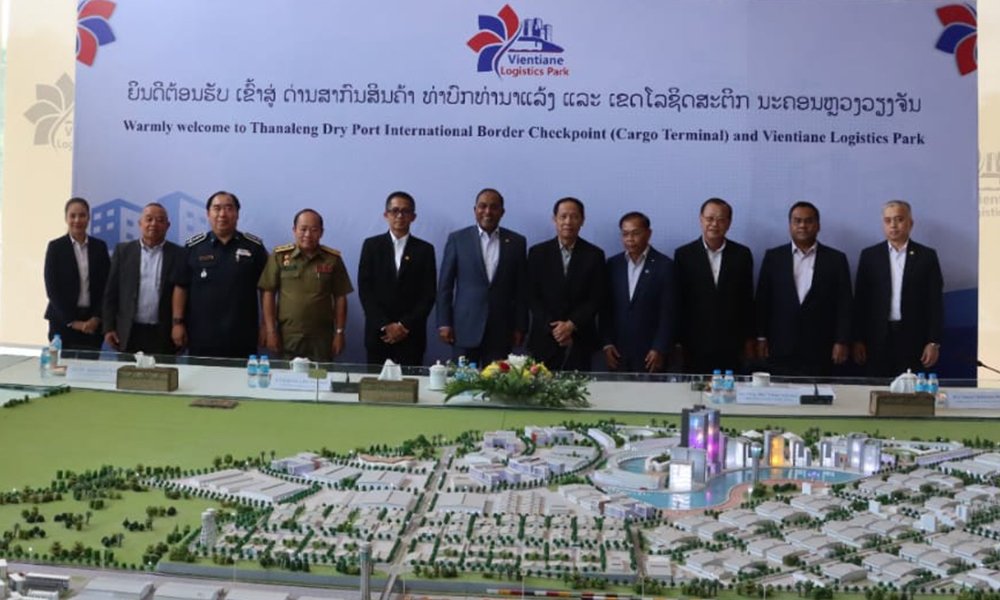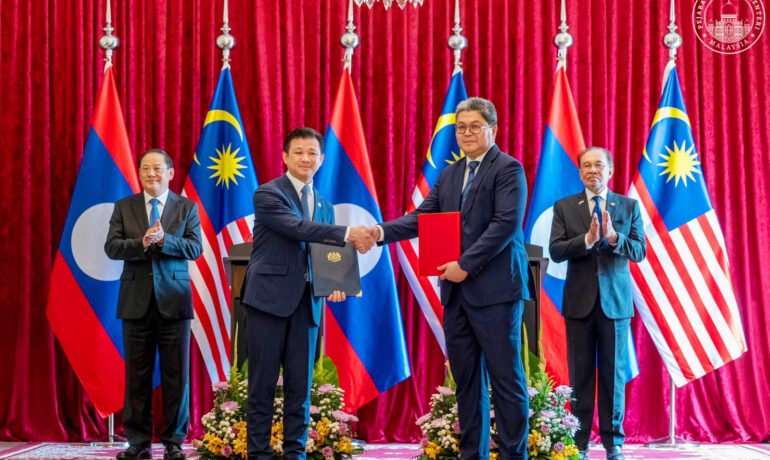As Laos becomes an increasingly important logistics and transport connector linking Southeast Asia, China and Europe, the shipment of freight through the country is very beneficial due to the cost-effective services provided and bolsters opportunities, the developer of the Thanaleng Dry Port told a Malaysian Minister.
Dato’ Seri Diraja Dr Zambry Abd Kadir, Malaysia’s Minister of Foreign Affairs and his entourage visited the Thanaleng Dry Port International Border Checkpoint (Cargo Terminal) and the Vientiane Logistics Park in Vientiane on June 26 and learned firsthand about the opportunities on offer.
Welcoming the delegation, Mr Alounkeo Kittikhoun, former Minister to the Prime Minister’s Office and current President of the Executive Board of Strategy and Planning at PTL Holding Company Limited (PTLH) – the parent company of Vientiane Logistics Park Co., Ltd. – briefed the group about the project.
Opening for service in December 2021, the dry port is a converging point between the Laos-Thailand and Laos-China railways. Through the Laos-China Railway, part of the planned regional Kunming-Singapore rail network, time is now cut by half to ship freight from Southeast Asia to Europe by rail, and Malaysia can link to this cost-effective trade route.
The dry port’s developer explained that from the Lao capital Vientiane, cargo can reach Laem Chabang, Thailand’s main deep seaport, about 150km south of Bangkok

From Bangkok, the trade route connects to the Malaysian capital Kuala Lumpur and even onwards to Singapore.
Through Laos, countries in Southeast Asia can now access the Chinese market.
From China’s megacity of Chongqing, the rail link, more than 11,000 kilometres long, crosses the border at Alashankou in the Xinjiang Uygur autonomous region, and then passes through Kazakhstan, Russia, Belarus and Poland before reaching Duisburg in Germany.
By sea, it takes about 45 days for cargo from Laem Chabang port in Thailand to reach Europe, but takes just over 10 days by rail.
“It is very crucial, it is the most direct route,” Mr Alounkeo told the guests, referring to the use of the rail network
In another direction, the trade route via Laos connects to the Vung Ang seaport in Vietnam’s Ha Tinh province by road.
With the aim of providing more cost-effective transport, a railway is planned to link the dry port to Vung Ang under the packaged Lao Logistics Link (LLL) project, which includes the Vung Ang seaport, the planned railway, and the dry port in Vientiane.
Thanaleng Dry Port’s Managing Director, Sakhone Philangam, said landlocked Laos has been transformed into a land link and logistics connector among countries in the region, in line with the Lao government’s development strategy.
To tap the trade and investment potential brought about by improved connectivity, Vientiane Logistics Park Co., Ltd. is also building a logistics complex where investors can set up operations.
The complex comprises seven zones, including a tank farm, export processing centre, logistics park, free trade zone, technology and halal hub, and administrative and office zone.
Investors benefit from number of incentives including a corporate tax holiday of 8-16 years and a Value-Added Tax reduction among others. Cheap electricity is another attractive option.
In addition, companies that manufacture or assemble goods in Laos will enjoy privileged access to major markets in countries whose governments have waived or reduced import tariffs on made-in-Laos products.
More than 30 countries including Australia, Canada, members of the European Union (EU 28), Japan, New Zealand, Norway, Russia, Switzerland and Turkiye have extended such special treatment to Laos.
ປະກອບສ່ວນອຸປະຖຳ ກອງປະຊຸມໃຫຍ່ ຜູ້ແທນ ອົງຄະນະພັກ ກະຊວງ ໂຍທາທິການ ແລະ ຂົນສົ່ງ ຄັ້ງທີ VI
ໃນວັນທີ 19 ກັນຍາ 2025 ທີ່ຜ່ານມາ, ກຸ່ມບໍລິສັດ ສິດທິໂລຈິສຕິກ ລາວ ຈຳກັດ,
ລາວ ແລະ ມາເລເຊຍ ໄດ້ເປີດຕົວເສັ້ນທາງ ການຄ້າທາງລົດໄຟ-ທະເລ ແຫ່ງໃໝ່
ລາວ ແລະ ມາເລເຊຍ ໄດ້ເປີດຕົວເສັ້ນທາງ ການຄ້າທາງລົດໄຟ-ທະເລ ແຫ່ງໃໝ່ ເພື່ອເສີມສ້າງລະບົບການຂົນສົ່ງໃນພາກພື້ນ, ສົ່ງເສີມການຮ່ວມມືທາງເສດຖະກິດ, ແລະ



